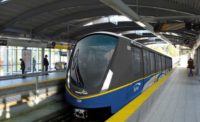

About eight inches per push—that is how the 3,400-ton Sellwood Bridge moved forward on Jan. 19 in Portland, Ore. The owner, Multnomah County, moved the 87-year-old, 1,100-ft-long steel truss 66 ft to the north using the span as a detour bridge, while a joint venture of Slayden Construction Group Inc., Stayton, Ore., and Sundt Construction Inc., Phoenix, builds a brand-new crossing over the Willamette River as part of a $299-million project.
The move occurred over 12 hours as 40 hydraulic jacks—each weighing 150 tons—lifted the 3400-ton steel span off its concrete columns. Ten 75-ton-capacity, digitally controlled hydraulic jacks inched it along tracks, moving the west end 66 ft and the east end 33 ft.
"That was the challenging part," says Slayden's project manager, Larry Gescher. "We were rotating more or less on an arc, so we had to get all our tracks set up in the right arc." And with a "complicated rotation point" to keep from hitting neighboring condominiums, Gescher says getting the exact arc was a tricky maneuver. But it was also necessary, as the longer move on one side cleared enough space for the new bridge's turn lanes, allowing crews to build the new structure in place without staging.
The Slayden-Sundt join venture called on rigging and transport subcontractor Omega Morgan, Hillsboro, Ore., for the actual move, originally projected to take between six and 12 hours. While the bridge's plodding move was hardly noticeable to the naked eye, there was plenty of monitoring throughout.
"Not only is the bridge really old, but it is also one continuous truss," Gescher says. "With no joints in the middle, there were lots of concerns with making sure it stayed in perfect horizontal and vertical alignment."
Sliding bridges in or out is an increasingly popular method in the U.S. Ed Wortman, a Multnomah County bridge engineer working on the move, says this may have been the first time a four-span truss has ever been moved as one single piece. The bridge truss slid across 10 beams on a U-shaped track system that held the bridge in place during the shift.
The beams acted as support for the bridge's bearing points, with two beams per original pier. To provide a slick surface, 14-ft-long, ski-shaped steel skid beams slid on Teflon pads glued to the track beams. The slickness meant the full capacity of the jacks—which sat inside the U-shaped tracks—wasn't required. The west-end jacks had to push twice as fast to make up ground.
With the move complete, crews spent only a few days anchoring the truss to the five new steel piers at the same spacing as the original bridge and installed temporary joints at each end of the bridge. Paving was the final step.
Using the aging structure for another two-plus years as a detour will allow the county to avoid dropping a bevy of short spans into a major Portland waterway. Work will begin immediately on the new steel-deck arch as well as a two-lane span that features two 6-ft-wide bicycle lanes, two 12-ft raised sidewalks and the capacity to add light rail in the future.











Post a comment to this article
Report Abusive Comment